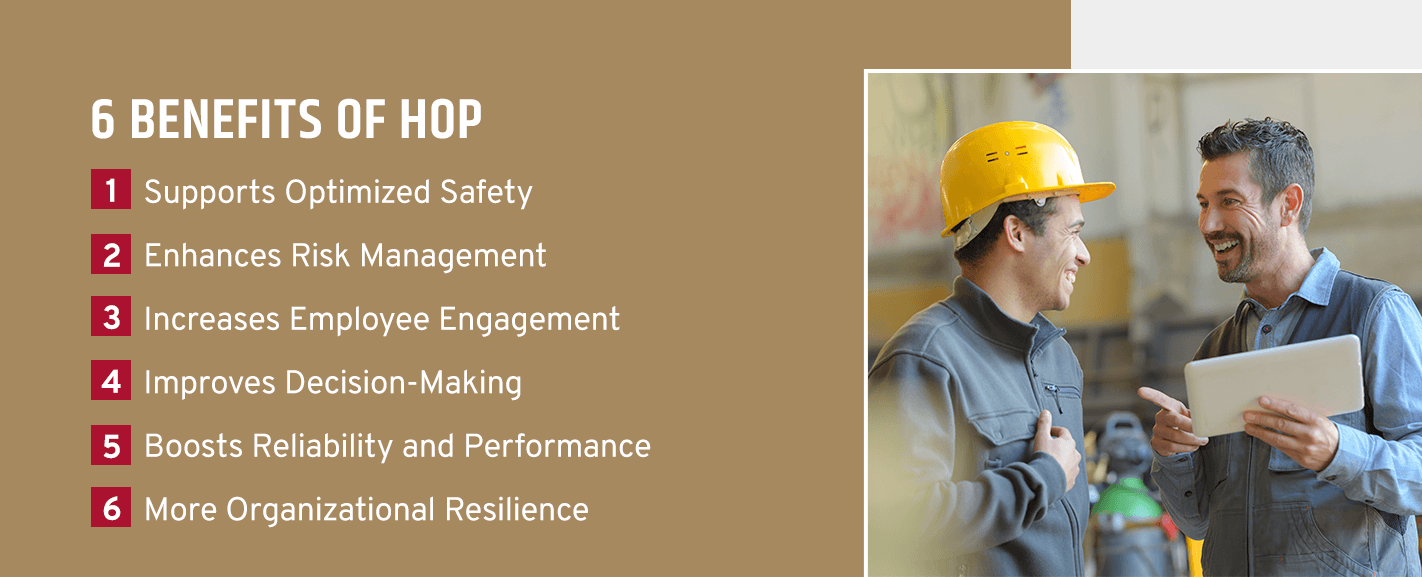What Is Human and Organizational Performance?

Human and organizational performance encompasses a shift in how organizations approach operational elements such as safety, efficiency, and reliability. It affects how we view the relationships between human workers, the complex systems they interact with, and an organization as a whole.
HOP can profoundly impact how companies view their employees and respond to incidents, ultimately driving increased safety and performance.
What Is HOP?
Human and organizational performance refers to a comprehensive framework and operating philosophy for safety professionals that uses social sciences to understand the complex interactions between an organization’s people and systems. It emphasizes a comprehensive safety approach that considers the following factors:
- Human contribution
- Organizational culture
- Existing incident mitigation systems
HOP ultimately makes exchanges safer, higher-performing, and more reliable by creating an environment dedicated to learning from mistakes rather than focusing on the people making errors. This approach can enhance organizational performance by stressing the underlying factors that can contribute to human error. It promotes a culture of learning and continuous improvement, helping organizations gracefully adapt to changing conditions and operational blunders.
The Primary Principles of HOP
HOP shifts how organizations understand and view their teams. It emphasizes the idea that people themselves are not problems. Instead, they are valuable problem-solvers in a complex system where humans, technology, and processes are inextricably interconnected. The principles of human and organizational performance are as follows.
- Everyone makes mistakes: A leading tenet of HOP is that all humans — even the top-performing employees — are likely to make errors. Organizations should anticipate that nobody is perfect, and fine-tuning systems and processes is a more effective way to mitigate issues than correcting a worker’s missteps or oversights.
- Blame is unhelpful: Another guiding principle of human and organizational performance is that identifying and assigning blame is counterproductive. Blame often inspires a culture of fear or defensiveness. Focusing on solving a problem at its root is more constructive and enables learning for future error prevention.
- Context determines action: The HOP philosophy also emphasizes the connection between circumstance and human behavior. People’s actions are often a direct response to their environment, so understanding the context in which someone made a decision is essential for accurately analyzing what went wrong, why it was incorrect, and the best way to intervene to boost performance.
- Leader response matters: A leader’s response to an error sets the tone for how the rest of the organization handles mishaps and failures. It is up to those in charge to demonstrate how to communicate, learn, and improve from their mistakes.
- Learn from your failures: Improvement happens through learning. HOP emboldens organizations to embrace their failures as a valuable opportunity to learn and grow together. By identifying the underlying causes of a mistake, teams can continuously find new corrective actions to implement to enhance overall safety, efficiency, and performance.
6 Benefits of HOP
Safety professionals can benefit from learning the ins and outs of the HOP approach to creating a better work environment for all. HOP provides many advantages for organizations.
1. Supports Optimized Safety
Human and organizational performance emphasizes a proactive approach to safety by identifying and addressing underlying risks before incidents occur. Organizations can find more robust solutions for supercharging safety across every interaction by analyzing systems and exchanges holistically, rather than assigning blame to employees.
This approach also promotes a culture of ongoing progress that emphasizes open communication and learning from every mistake, enabling businesses to increasingly strengthen their safety practices.
2. Enhances Risk Management
Another reason to implement the HOP approach to safety is enhanced risk management — recognizing humans are fallible and understanding that the complex systems they work with require updating and redesign to combat errors.
Analyzing the system’s performance helps organizations identify weaknesses and risks employees could accidentally exploit. It lets them find ways to improve processes and procedures to reduce the likelihood of an error occurring in the first place.
3. Increases Employee Engagement
Human and organizational performance can enhance employee engagement by empowering team members to constantly evolve and improve despite the mistakes they may have made. This approach to safety encourages workers to acquire new knowledge and competencies in their roles without fear of making an error.
Fostering highly engaged employees is essential for organizations looking to maximize performance and safety. By giving workers the autonomy and grace to learn from their errors, organizations can foster greater collaboration, attention to detail, and purpose in their work.
4. Improves Decision-Making
HOP considers an organization’s dynamics, human factors, and system complexities. Looking at all these elements cohesively can empower decision-making and help organizations understand the impacts of their choices on the system at large. This mindset enables more informed and comprehensive decision-making, avoiding biases and assumptions to focus on the most impactful system improvements possible.
5. Boosts Reliability and Performance
Another top benefit of human and organizational performance is its emphasis on continuous learning and adaptation to drive overall improvement. Leaders must closely analyze the following to gain finer control over their performance:
- Operational data
- Near-misses or errors
- Incidents and mistakes
Learning from past blunders is the best way to drive change that fosters boosted reliability and performance.
6. More Organizational Resilience
HOP focuses on building long-term resilience within an organization. It helps people anticipate errors and quickly recover from their impact. Organizations can continue operations with minimal disruption by strengthening the response to incidents and risks.
HOP ultimately helps organizations take a proactive approach to safety and adapt to changing conditions, allowing them to thrive despite the uncertainty of human error.
Obtain the Human and Organizational Performance Certificate From the National Association of Safety Professionals
The National Association of Safety Professionals (NASP) offers a Human and Organizational Performance Certificate for those seeking a comprehensive understanding of HOP through independent study.
This certificate course will help you gain valuable insight into how to supercharge organizational performance and resilience. There are no prerequisites for this program, and you have six months to work through the course’s content and complete the accompanying exams.
Contact us today to learn more about our extensive online catalog of courses and certificates.
Blog Posts
Latest Posts
Related Posts






